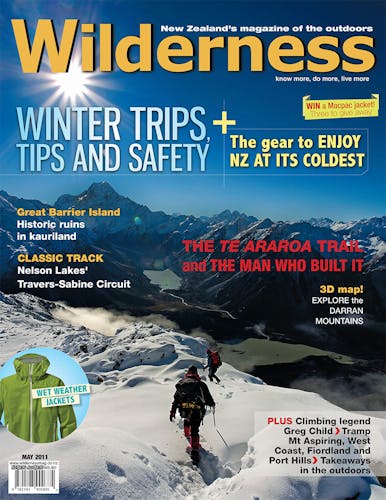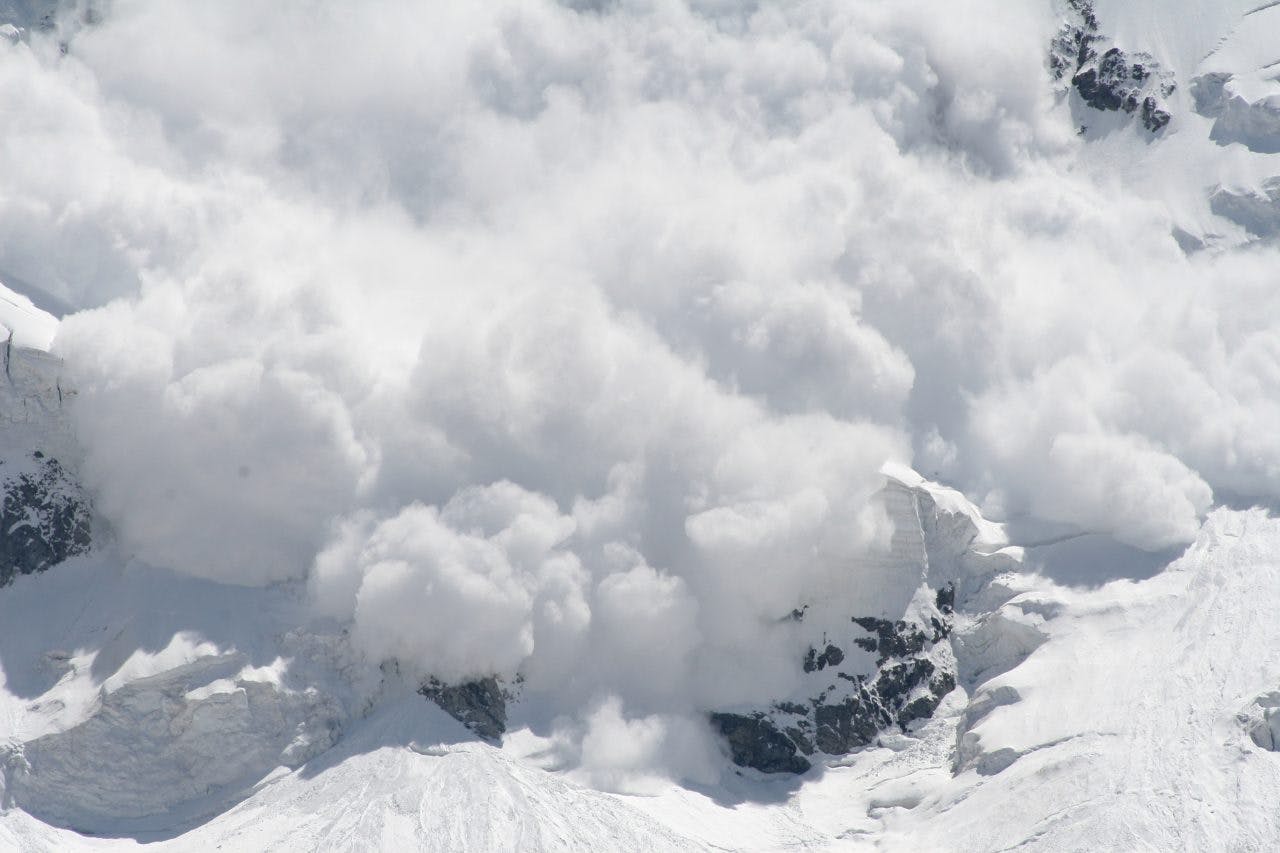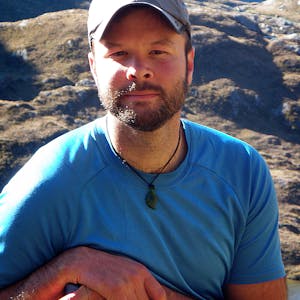Avalanche awareness is about learning to take calculated risks and knowing when to call it a day, writes Mark Banham
“Mind if I take a photograph of you guys?” the tourist said. “I’ll be able to sell it for a fortune when you don’t come back.” Through his thick Aussie accent it was hard to tell if he was joking, but as he pulled the lens-cap off his oversized camera and started to frame us up it seemed he was serious about the photo. “Say cheese!”
I shouldered my pack alongside Adrian and Louise, all of us trying to smile confidently as yet another avalanche thunderously peeled off the sun-baked slope of Mt Annette. “Don’t you mean if we don’t come back?” I said.
“Of course mate, of course! I’m sure you guys will be totally fine. You have the time of your lives up there, eh.”
As we crammed the last few bits of gear into our already massively overloaded packs, ready for a ski touring trip up to Mueller Hut, the day’s cool southerly forecast was warming up faster than we’d expected.
A thousand metres above us, the blazing sunshine was cooking the snowpack, lubricating it, weakening it and weighing it down with melt-water. Every half-hour or so gravity would prevail and an avalanche would release, accelerating down into the valley, funnelling into a river of slush and pitching noisily off small cliffs until it eventually petered out in the jagged scree below.
These slow moving spring slides weren’t the spectacular hundred-mile-an-hour destructo-clouds most people envisage when you say ‘avalanche’ but if they swept one of us off a cliff we’d be just as dead.
For the tourists, this bluebird spring day with its avalanche spectacle made for some great photos. But for us – facing either a sullen five-hour drive back home, or a scary climb to the hut – it meant some tough decisions.
In truth, I had no excuses for making a bad call. Only a few weeks beforehand, I had the chance to attend one of the Mountain Safety Council’s Backcountry Avalanche Courses (BAC), designed to equip skiers and snowboarders to make just this sort of decision.
The BAC is somewhat unique among avalanche education courses in New Zealand. A lot of avalanche training is aimed at giving aspiring ski patrollers the necessary skills to do their jobs. Those courses are focused on digging pits, measuring temperatures, analysing crystals; essentially turning the mountains into a laboratory with a view to making a relatively small area – a ski resort – 100 per cent safe.
The problem is, in many respects ski tourers have a more difficult job than patrollers. Whereas patrollers only have to make decisions regarding a small number of slopes, ski tourers can cover a huge area – and they ski a different mountain each weekend. Plus of course tourers (hopefully) don’t have the benefit of controlling slopes with explosives.
The MSC’s answer to this conundrum – the BAC – trains tourers to think beyond just digging pits, teaching them to look at the broader backcountry environment. In four-and-a-half days this course teaches intermediate ski tourers about snow analysis and avalanche behaviour, but importantly it places the emphasis on planning, route selection and rescue.
Essentially it’s an application of the 80-20 rule; if you can collect 20 per cent of the information, it should allow you to make decisions about 80 per cent of the terrain. The trick, of course, is picking the right information and the right terrain.
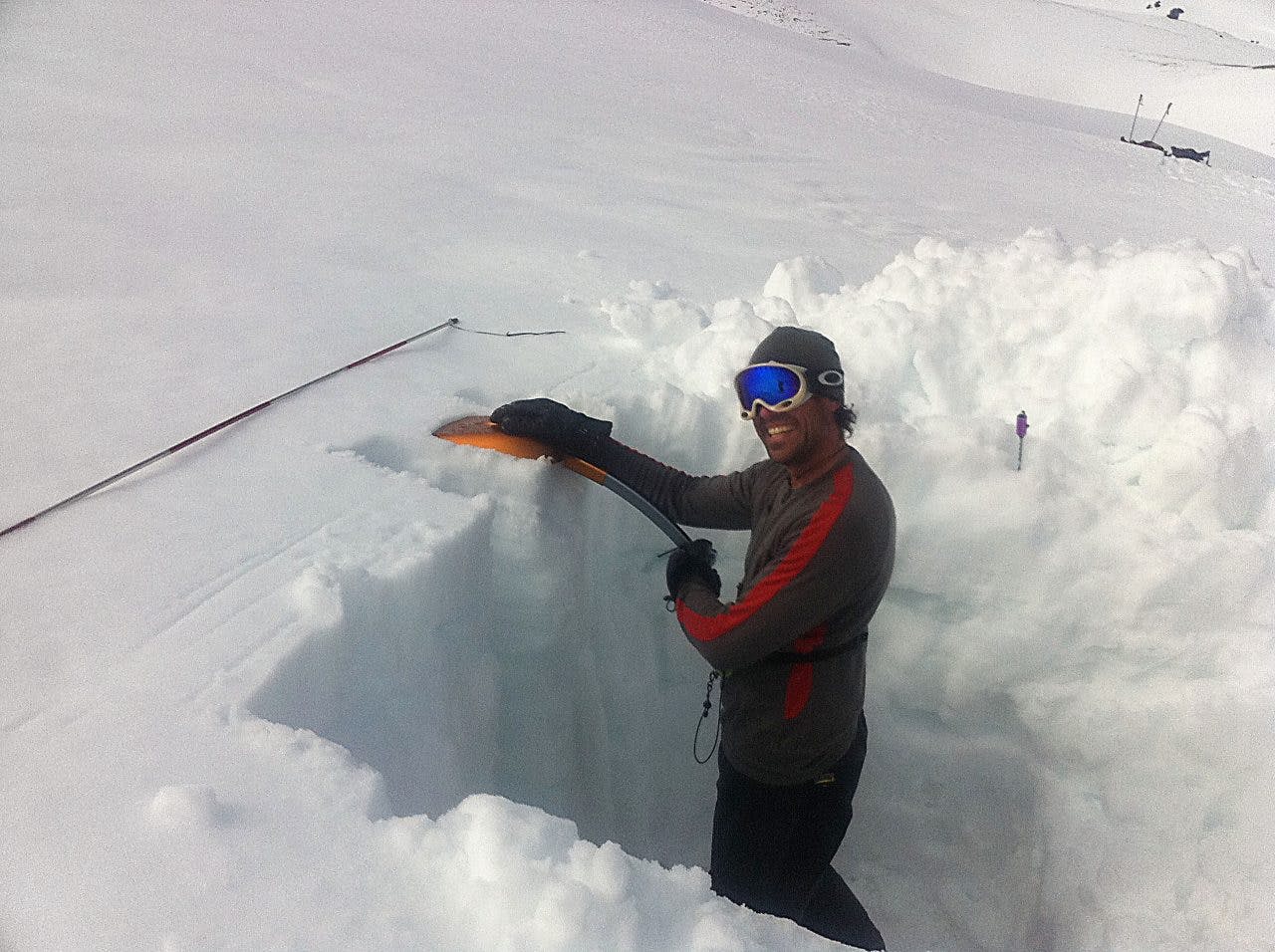
Test pits like this are a useful tool, but they can give widely varying results and only apply to a specific slope angle, aspect and elevation – so ski tourers need to take a wider view. Photo: Mark Banham
Lesson one: Make a list and check it twice
Like school kids, on this course you’ve got to do your homework before you can go out and play. The first evening was spent with Lee Blazek, a heli-ski guide, veteran of 24 winters and our instructor for the course, in the classroom going over some theory and getting to grips with some of the checklists that would be our constant companions for the next few days.
Firstly there’s a checklist of fairly common-sense (sadly an oxymoron these days) trip planning considerations: Has everyone got the right gear? What has the weather been in the last 48 hours and what is it expected to do today? What’s the avalanche advisory rating? Then there’s more checklist to evaluate each individual slope and make terrain choices: What’s the slope angle? What’s the likelihood of it avalanching? Is it getting worse and what are the consequences if it does go?
I’ve often said skiing, with its cocktail of effortless speed and gravity and centrifugal forces has a lot in common with flying – but when you add in the checklists it really starts to feel aeronautical. I could see my next conversation with my ski touring buddies already:
“Engaging binding and turning to heading one-niner-zero, altitude two thousand metres, slope angle four-zero degrees; snow conditions in couloir; thirty centimetres unconsolidated new snow on a firm base.”
“Thirty centimetres! Surely you can’t be serious!”
“I am serious… and stop calling me Shirley.”
Lesson Two: Train as you mean to race
Outside on the snow with skis on is where this course really gets up to speed. From the moment we click into our bindings we’re going through a constant decision making cycle – those checklists come back with a vengeance: are you on avalanche terrain? What about now? Could it slide? Is it getting worse? It seems the habit of constantly checking and cross-checking yourself is something these guys are really big on.
Inevitably, the curriculum turned rescue. On that subject the BAC motto seems to be “train the way you intend to race” (and with survival rates that drop precipitously with every minute of burial, this stuff is definitely a race) so transceiver searches are done on the sort of slope you’d experience an avalanche on – about 500m long by 200m wide and black-diamond-run steep, with a ‘victim’ (a backpack with a transceiver in it) buried on it somewhere.
Starting with no signal at all I confidently made broad passes across the slope looking for a transceiver signal – in no time at all I’d picked it up – and in even less time I’d misread my transceiver and skied 50m downhill past it. D’oh!
In soft snow and on a steep slope there was absolutely no way I was going to get back up to it with my skis on. So off they came for a lung-busting wade back up the slope. By the time I’d located the burial site, my chest was pounding and the sweat was running into my eyes – and I hadn’t even started digging yet.
By this stage Lee was looking at his watch and shaking his head – not a good sign. In a training context losing a few minutes because you’re not 100% familiar with your gear is frustrating as hell – but if it were the real thing, those few wasted minutes might make the difference between extracting a hypothermic victim and an unconscious one – or worse.
That night I went home and read my transceiver’s instruction manual cover-to-cover. I went to sleep muttering my newly penned powder-hound’s creed;
“This is my transceiver. There are many like it, but this one is mine. My transceiver, without me, is useless. Without my transceiver, I am useless…”
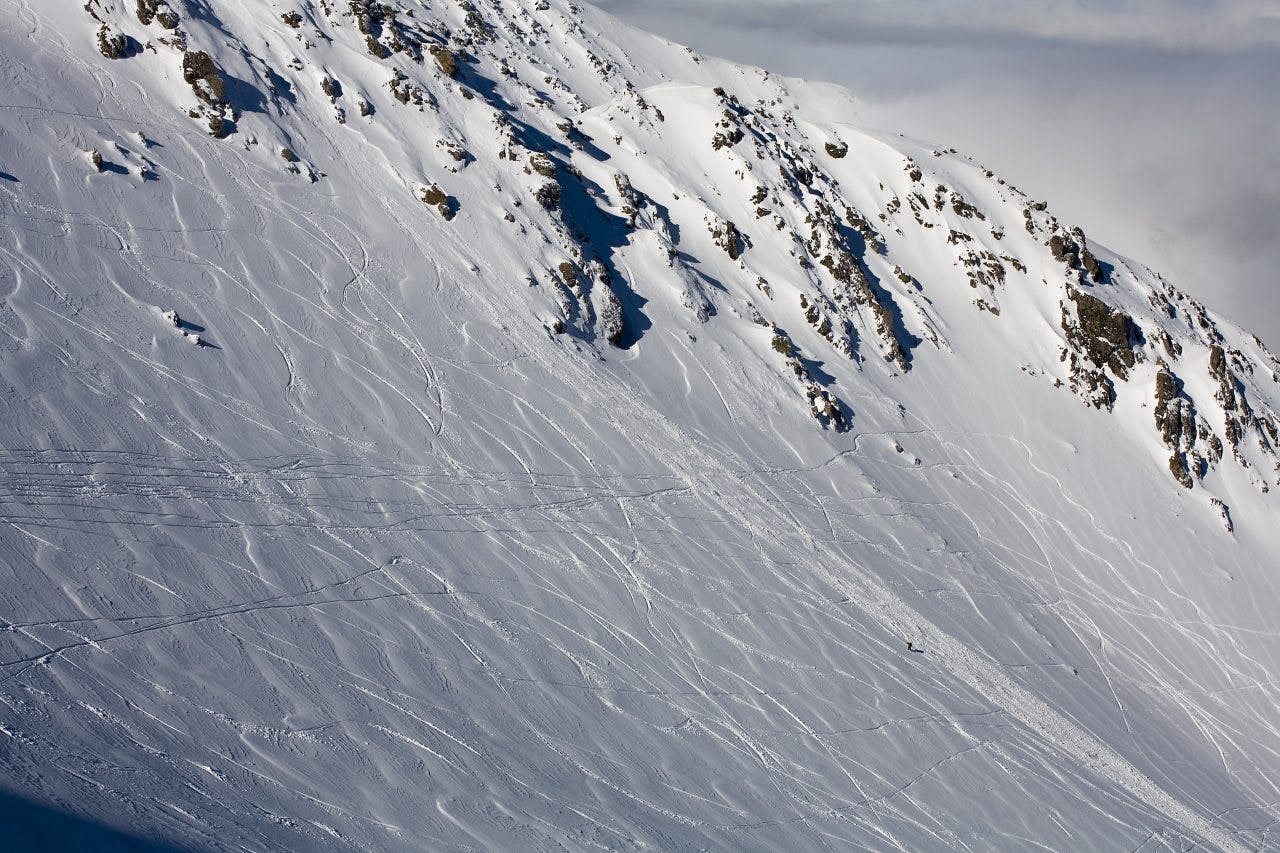
A very lucky skier walking away from an avalanche in the Craigiburn backbowls. Photo: Mark Banham
Lesson Three: The team that works together, lives to play another day
On the snow the next day it was time for the final test – group digging. It seems somewhat silly, but most avalanche training focuses on finding a buried skier and the actual process of excavating them often gets glossed over.
Digging out an avalanche victim sounds straightforward but in practice trying to coordinate a chain gang of diggers so that no one gets a shovelful of snow in the face takes a bit of doing. The trick is to dig horizontally with a couple of people ‘at the coal-face’ making headway and the others behind them just moving the tailings away – remembering of course to rotate jobs frequently.
When done well it’s a carefully choreographed performance but that takes a bit of practice. For us it was more, ahem, utilitarian – we managed to dig down two metres in about 10 minutes – not bad going, but it certainly wasn’t pretty.
Rescue exercises like this are enlightening, but Lee points out the thing to remember with all this is avalanche rescue techniques – essential as they may be – are secondary to good terrain selection and group management. “The thing is not to get caught in an avalanche in the first place.”
Meanwhile, back in the real world…
Back at the foot of the Mueller Hut route, Lee’s words were repeating in my mind on an endless loop – don’t get caught, don’t get caught… .
But then something strange happened: I found myself beginning to quietly run through those ‘tiresome’ checklists: ‘Are we in avalanche terrain? Yes. Could it slide? Yes – in fact it is. What are the consequences? Potentially really bad. Is it getting worse? No, in fact it’s getting better.’ And it was that last point on the checklist that saved the day.
We reasoned that as the sun moved off the slope we were planning to ski, the temperature should drop and the snowpack should gain strength – or at least stop loosing it. We’d climb up and if we didn’t like the look of it we’d just wait until things improved – if necessary making the ascent by headtorch that evening.
As we climbed past 1500m, the snow – now in the shade – seemed wet but reasonably cohesive. Not ideal, but definitely doable. On the way up we passed a few people; some like two experts from Mt Cook Search and Rescue who had clearly gone through a similar logical process before deciding the risks were acceptable and heading out – and others like a lone tourist in cheap PVC rain pants and a t-shirt who’d clearly just ignorantly wandered up there – probably to get a better photo of Mt Cook.
In my humble opinion that’s what this sort of training is all about – it’s not necessarily about being safe; after graduating the course you can choose to use your new found knowledge to reduce the risk of your normal activities, or to push your boundaries while maintaining the same level of risk.
For me it’s really about learning how to take carefully calculated risks like the experts rather than blindly wandering in like the tourists.
Find a BAC near you!
New Zealand Mountain Safety Council Backcountry Avalanche Course dates:
North Island
Turoa, September 29 – October 2
Whakapapa, August 29 – September 1
South Island
Canterbury, August 20/21 and 27/28
Arthurs Pass, July 6-9 and September 13-16
Wanaka, September 5-8
Queenstown, July 18-21 and September 5-8
Cost $650 for the four and a half days’ tuition. MSC can rent you transceivers, shovels and probes if needed and discounted lift tickets are available if required.
More Info www.mountainsafety.org.nz





